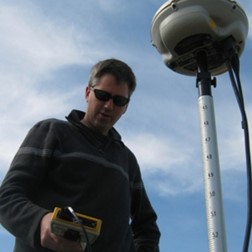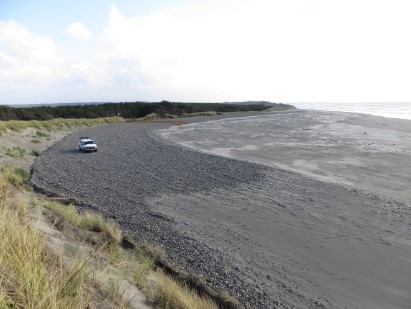The Takeaway: Learn how dynamic revetments are being used in high wave energy locations to reduce erosion.
Overview
Erosion along coastal Oregon can be significant following large storms. There are relatively few non-structural options to mitigate erosion in this high wave energy environment. The state of Oregon also has strict policies on where and what development can use structural erosion control along the coastline. For those who are unable to use structural measures (such as riprap and seawalls), dynamic revetments may be an option.
Oregon Department of Geology and Mineral Industries, the College of Earth, Ocean, and Atmospheric Sciences at Oregon State University, and federal partners have been evaluating dynamic revetments at several sites on the Oregon coast. In each case, the cobble berm was developed to emulate nature, and has proven effective at tackling erosion in high wave energy conditions. Jonathan Allan, a coastal geomorphologist with Oregon Department of Geology and Mineral Industries, shares two dynamic revetment projects designed to address erosion along Oregon’s coast.

Lessons Learned
- A dynamic revetment, variously known as a gravel or cobble berm, is a “design with nature” approach that can mitigate coastal erosion hazards in certain locations. Studies of naturally occurring gravel beaches have revealed that they are remarkably stable in the face of sustained wave attack. This is because of their high threshold of motion relative to sand, requiring large swash velocities to mobilize the gravel. Due to asymmetry of swash velocities under most conditions on the beach face, there is a greater propensity for cobbles to be transported up the beach face (i.e., to the back of the beach), where they form a berm. With sufficient volume and particle size, the cobble berm tends to be more resistant to wave attack than the natural sand beach, and has been demonstrated to mitigate erosion of the backshore.
- Preference should be given to those areas where there is existing evidence of gravel on the beach. Although a dynamic revetment could be potentially constructed on a pure sand beach, they may be better suited in areas where there is existing gravel, either on the beach or back beach, or evidence of buried gravel in the beach and dune. It will also be less disruptive to the character of the beach to add gravel to an already gravel beach rather than to a purely sandy beach. Examples from the Oregon coast cover the spectrum of potential sites, ranging from areas that already contain natural cobble on the beach (e.g., Cape Lookout State Park), to a site where cobble was added to a pure sand beach (e.g., the Columbia River South Jetty), to sand beaches present within an estuary (e.g., Hatfield Marine Science Center, Newport.
- Plan to maintain a dynamic revetment. All infrastructure needs to be maintained, and dynamic revetments are no exception, since the cobble may be removed and transported along the beach, feeding downdrift locations. Maintenance usually requires replacement or addition of more cobble over time. Finding suitable and sufficient gravel sources for construction and maintenance can be challenging. Case studies from the Oregon coast have indicated that the cobble would be rounded, more than 64 mm in size (small cobble), and basalt, since that’s most abundant and abrasion is slower. Some of the projects were able to acquire materials from nearby sites where the cobble had moved due to long-shore transport. Transporting gravel from remote source locations did drive costs up.
- There’s no “one-size-fits-all” design template for dynamic revetments. Dynamic revetments need to be tailored to site conditions. There is a well-established (engineering design) approach with riprap structures. However, with dynamic revetments the objective is to construct the cobble berm so that it mimics the form and behavior of natural gravel beaches to ensure stability and compatibility with the natural environment (source: Monitoring The Response And Efficacy Of A Dynamic Revetment Constructed Adjacent To The Columbia River South Jetty, Clatsop County, Oregon.) Each project is unique depending on the site characteristics. Since cobble size and type will vary by geography, an engineer would need to identify what is occurring naturally or needed for that site’s conditions, and then assess the prevailing wave directions and energy, cobble volume, design crest elevation, slope and size, and type of rock needed for that specific site.
- Design flaws served as an opportunity to test the structure's capacity. The Cape Lookout State Park project had an inherent design flaw in that because there was insufficient cobble in the area, the structure was not able to be built to the right design crest elevation to prevent overtopping. To address this limitation, it was decided that an artificial dune would be built landward of the cobble berm, which would help mitigate wave overtopping and inundation of the campground. The combined roles of both structures provided a unique opportunity for Oregon Department of Geology and Mineral Industries and the College of Earth, Ocean, and Atmospheric Sciences Oregon State University to monitor the effectiveness of both structures to withstand the effects of extreme storm waves combined with high tides, and see how such a prototype structure would perform.
- Dynamic revetments are most effective on a large scale. An individual oceanfront homeowner is unlikely to have the ability to construct a dynamic revetment that will be effective at such a small scale. Therefore, a large development (such as a campground) or neighborhood of homes may be a more appropriate scale for this type of approach.
The Process
Oregon Coast
The Oregon coast is affected by large winter storms that can generate huge waves. Winter storms can generate ocean waves (greater than 10 meters) that cause bluff and dune erosion. High water levels, combined with large storm waves, are the major factors that drive the erosion; during extreme spring tides, the tidal range can be three to four meters (source: Oregon Coastal Hazards Ready Library and Mapper).
Mitigating erosion can be challenging due to the high-wave energy from these extreme storms and high water levels. In the past, people used rock riprap revetments and seawalls as protection against erosion. However, Oregon’s statewide planning goals and guidelines (Goal 18: Beaches and Dunes), which are meant to conserve and protect coastal beaches and dunes, do not allow development built after January 1, 1977, to use protective structures like seawalls, riprap revetments, and breakwaters as erosion control measures. This is because these barriers are static and block the transport of sand, diminishing the public beach over time.
Dynamic Revetments
In some locations, dynamic revetments or cobble berms are being used as an alternative to hard engineering solutions like riprap revetments and sea walls to help mitigate coastal erosion. Dynamic revetments use cobble or gravel to mimic a natural cobble beach. They work because the cobble or gravel has a greater tendency to remain high on the beach face as a berm, dissipating the wave energy—and given sufficient volume—can reduce or even stop dune or backshore erosion. This contrasts with sand particles, which when eroded, are removed offshore to form bars, lowering the beach face and allowing waves to erode into the backshore. Importantly, as the gravel moves about in response to waves, the shape of the cobble berm changes, allowing the wave energy to be dissipated. Because the gravel and cobbles are expected to be moved by waves and currents, the revetments are able to adjust their shape in response to the prevailing wave conditions. A dynamic revetment may therefore be constructed along the beach or bluff in front of an eroding property. Maintenance requirements for such structures include keeping the volume of cobble at the right level and in the right place.
According to research done by Ward and Ahrens in 1991, there are several advantages to using dynamic revetments to protect properties.
- Costs are lower since they do not require large stones like those used in conventional riprap.
- Stones can be dumped at the site and don’t have to be individually placed, which makes construction simpler.
- Movement of gravel doesn’t mean the project is failing, but rather is a sign that the gravel berm is adjusting its shape to reflect the predominant storm wave conditions.
- The appearance of natural gravel beaches can be more aesthetically pleasing compared to a seawall or riprap revetment.
Cape Lookout State Park Dynamic Revetment
Jonathan Allan, coastal geomorphologist with Oregon Department of Geology and Mineral Industries, and Dr. Paul Komar, College of Oceanic and Atmospheric Sciences, Oregon State University, worked with the Engineer Research Development Center from the U.S. Army Corps of Engineers to monitor a dynamic revetment at Cape Lookout State Park (Tillamook County, Oregon) to help lessen erosion. The original design of the structure was developed by Drs. Paul Komar and Jim Good from College of Oceanic and Atmospheric Sciences, Oregon State University.
Once an area with a wide sandy beach and high dunes covered in thick vegetation sheltering the campground, the site experienced erosion for many years, leading to the eventual destruction of the primary dune protecting the campground. Beaches on this part of the Oregon coast can be categorized as composite beaches, meaning they have a backshore with a steep-faced gravel berm that transitions into a wide and gently sloping dissipative sand beach. Building a dynamic revetment cobble berm on this site would effectively mimic what was naturally there already.
In 1999, a dynamic revetment was installed to help restore the eroding dune and to protect the nearby campground. There had been a cobble beach at this location, so the team emulated it with a dynamic revetment. The project was done in two phases. The first phase focused on building an artificial dune at the back of the beach using sand-filled geotextile bags. The sand came from an area south of the park. This area was chosen since it was blowing onto a nearby road, causing issues. They excavated sand that had been transported and placed these in large sand bags that were stacked to form an artificial dune. Next, the dune was overlaid with jute coconut fiber cloth and planted with native grasses.
Phase two consisted of building the cobble berm. The Oregon State Parks and Recreation Department repurposed cobble that had been transported north of the site during storms. The idea with this particular dynamic revetment was to use materials that were naturally present at the time. Cobble was extracted from two locations in the park where natural accumulation had occurred—a natural cobble beach in the north area along a spit, and the south end. The cobble was placed evenly across the pre-existing profile of the natural cobble beach. The completed dynamic revetment was 300 meters long. The artificial dune constructed landward of the berm had a crest elevation of seven to nine meters in height.
The Oregon State Parks and Recreation Department constructed the dynamic revetment and the dune. The project cost about $125,000 at the time, compared to the $500,000 estimate for a traditional riprap revetment project. The project was completed in 2000 and has performed well, with periodic maintenance to replace lost cobble. Initial surveys showed that the constructed berm and foredune did not meet design specifications for required elevations needed to limit wave overtopping.
“This design flaw actually served as a test case to see the project’s capacity to withstand extreme waves and tides,” said Jonathan Allen. “The structure has withstood multiple large Pacific Northwest winter storms, which included waves that periodically overtopped the dynamic revetment.”
The project has required maintenance, which included adding cobble to the dynamic revetment. Although some lengths of the berm were not built to design elevations, the use of the cobble berm with the artificial dune has proven to be an effective strategy to protect the campground from the effects of storm waves. And even with maintenance, it has cost less than the construction of a seawall or conventional rock revetment. This project provided the first real test of a dynamic revetment to the extreme Oregon wave climate.
Jonathan also talked to many people using the beaches, and they had no sense that they were on an artificial structure, “which is great, since the collective vision was to make it look and operate like nature,” says Jonathan.


The Columbia River’s South Jetty Dynamic Revetment
The U.S. Army Corps of Engineers designed and constructed a dynamic revetment on the Columbia River’s south jetty spit. This area had been experiencing significant erosion of the primary foredune adjacent to the jetty root, and there was concern that the spit would eventually be breached by the combined effect of large storm-wave runup and high tides during storms.
The Army Corps’ Portland district designed a dynamic revetement to mitigate the erosion and contracted with Oregon Department of Geology and Mineral Industries to establish a beach and shoreline monitoring system along the study area in order to evaluate the structure’s response. This was a large project: a 330-meter-long structure using 33,600 cubic meters of gravel, both small (aggregate) and well-rounded (100 to 150 mm range). The Army Corps had to source the cobble from Washington State, which was expensive to transport.
This project resulted in some unexpected benefits. The dynamic revetment accumulated gravel rapidly, due to a sacrificial area adjacent to the jetty, which helped to further build cobble berm. Because the Army Corps designed the structure to have a broad crest (20 meters high), it allowed for sand to accumulate on top of the dynamic revetment. Over time, further accumulation of sand has effectively reduced the potential for wave overtopping. This process was aided by the natural spread of beach grasses on the dunes, which helped stabilize the aggrading sand and created bird and animal habitats. The Columbia River south jetty dynamic revetment has been extremely effective, as it has mitigated wave runup by shifting it further westward onto the gravel berm, prevented wave overtopping, and is protecting the spit from being breached. In September 2021, the structure received its first maintenance top-up, adding about 5,000 cubic meters of additional cobble, which is not unexpected given the extreme wave environment that the structure is exposed to.


Outcomes
“There is a lot of interest in these types of approaches,” Jonathan shares. “I’m seeing a growing need to use softer engineering. There are contractors building dynamic revetments in California, Washington, and other parts of Oregon. Even had some inquiries from the east coast. They are attractive because there is not a lot of engineering involved. You need to think about the volume of material, the elevation of the berm, and the slope. You can place the material with a bulldozer and let nature do the rest.” Oregon State University is working on improved design standards and guidelines, including better calculations of wave run-up on cobble beaches. “It’s an evolving technique,” he says.
